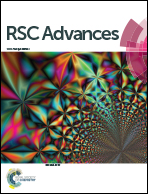Enhancing the performance of LARP-synthesized CsPbBr3 nanocrystal LEDs by employing a dual hole injection layer†
Abstract
Lead halide perovskites have been considered promising materials for optoelectronic applications owing to their superior properties. CsPbBr3 nanocrystals (NCs) with a narrow particle size distribution and a narrow emission spectrum are synthesized by ligand-assisted re-precipitation (LARP), a low-cost and facile process. In inverted CsPbBr3 NC LEDs, a dual hole injection layer (HIL) of 1,4,5,8,9,11-hexaazatriphenylene-hexacarbonitrile (HAT-CN)/MoO3 is introduced to enhance hole injection and transport, because HAT-CN can extract electrons easily from the hole transport layer and leave a large number of holes there. The current and power efficiencies of the optimized device with a dual HIL are 1.5- and 1.8-fold higher than those of the single HIL device. It is believed that the dual HAT-CN/MoO3 HIL effectively promotes hole injection and has promise for application in many other devices.



 Please wait while we load your content...
Please wait while we load your content...